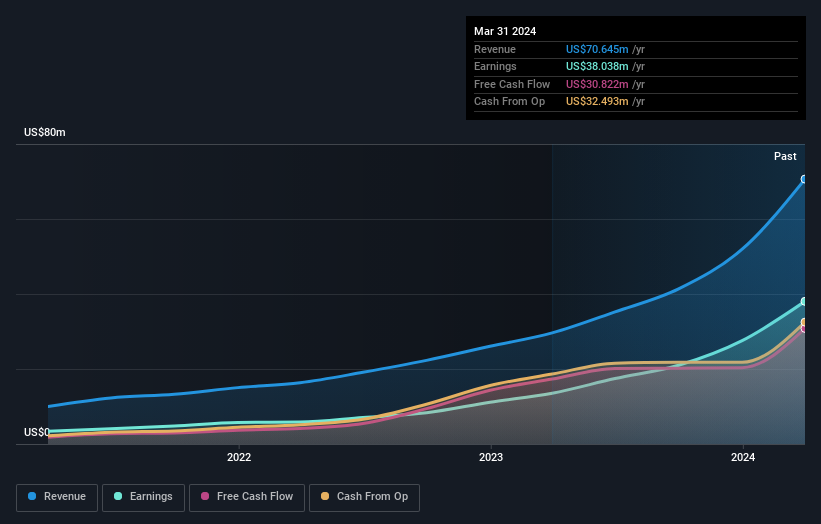- Israel
- /
- Electronic Equipment and Components
- /
- TASE:NXSN
Institutional owners may ignore NextVision Stabilized Systems, Ltd.'s (TLV:NXSN) recent ₪280m market cap decline as longer-term profits stay in the green

Key Insights
- Institutions' substantial holdings in NextVision Stabilized Systems implies that they have significant influence over the company's share price
- A total of 8 investors have a majority stake in the company with 51% ownership
- Insider ownership in NextVision Stabilized Systems is 31%
To get a sense of who is truly in control of NextVision Stabilized Systems, Ltd. (TLV:NXSN), it is important to understand the ownership structure of the business. The group holding the most number of shares in the company, around 34% to be precise, is institutions. In other words, the group stands to gain the most (or lose the most) from their investment into the company.
Institutional investors was the group most impacted after the company's market cap fell to ₪3.6b last week. Still, the 137% one-year gains may have helped mitigate their overall losses. They should, however, be mindful of further losses in the future.
Let's delve deeper into each type of owner of NextVision Stabilized Systems, beginning with the chart below.
View our latest analysis for NextVision Stabilized Systems

What Does The Institutional Ownership Tell Us About NextVision Stabilized Systems?
Institutional investors commonly compare their own returns to the returns of a commonly followed index. So they generally do consider buying larger companies that are included in the relevant benchmark index.
As you can see, institutional investors have a fair amount of stake in NextVision Stabilized Systems. This implies the analysts working for those institutions have looked at the stock and they like it. But just like anyone else, they could be wrong. If multiple institutions change their view on a stock at the same time, you could see the share price drop fast. It's therefore worth looking at NextVision Stabilized Systems' earnings history below. Of course, the future is what really matters.

We note that hedge funds don't have a meaningful investment in NextVision Stabilized Systems. Looking at our data, we can see that the largest shareholder is Yosef Sandler with 10% of shares outstanding. Meanwhile, the second and third largest shareholders, hold 9.1% and 7.3%, of the shares outstanding, respectively. Boris Kipnis, who is the second-largest shareholder, also happens to hold the title of Top Key Executive. In addition, we found that Michael Grosman, the CEO has 1.3% of the shares allocated to their name.
We did some more digging and found that 8 of the top shareholders account for roughly 51% of the register, implying that along with larger shareholders, there are a few smaller shareholders, thereby balancing out each others interests somewhat.
While it makes sense to study institutional ownership data for a company, it also makes sense to study analyst sentiments to know which way the wind is blowing. Our information suggests that there isn't any analyst coverage of the stock, so it is probably little known.
Insider Ownership Of NextVision Stabilized Systems
The definition of an insider can differ slightly between different countries, but members of the board of directors always count. The company management answer to the board and the latter should represent the interests of shareholders. Notably, sometimes top-level managers are on the board themselves.
Insider ownership is positive when it signals leadership are thinking like the true owners of the company. However, high insider ownership can also give immense power to a small group within the company. This can be negative in some circumstances.
Our information suggests that insiders maintain a significant holding in NextVision Stabilized Systems, Ltd.. Insiders have a ₪1.1b stake in this ₪3.6b business. This may suggest that the founders still own a lot of shares. You can click here to see if they have been buying or selling.
General Public Ownership
With a 29% ownership, the general public, mostly comprising of individual investors, have some degree of sway over NextVision Stabilized Systems. This size of ownership, while considerable, may not be enough to change company policy if the decision is not in sync with other large shareholders.
Private Company Ownership
We can see that Private Companies own 5.8%, of the shares on issue. It might be worth looking deeper into this. If related parties, such as insiders, have an interest in one of these private companies, that should be disclosed in the annual report. Private companies may also have a strategic interest in the company.
Next Steps:
I find it very interesting to look at who exactly owns a company. But to truly gain insight, we need to consider other information, too. Like risks, for instance. Every company has them, and we've spotted 2 warning signs for NextVision Stabilized Systems (of which 1 is significant!) you should know about.
Of course, you might find a fantastic investment by looking elsewhere. So take a peek at this free list of interesting companies.
NB: Figures in this article are calculated using data from the last twelve months, which refer to the 12-month period ending on the last date of the month the financial statement is dated. This may not be consistent with full year annual report figures.
Valuation is complex, but we're here to simplify it.
Discover if NextVision Stabilized Systems might be undervalued or overvalued with our detailed analysis, featuring fair value estimates, potential risks, dividends, insider trades, and its financial condition.
Access Free AnalysisHave feedback on this article? Concerned about the content? Get in touch with us directly. Alternatively, email editorial-team (at) simplywallst.com.
This article by Simply Wall St is general in nature. We provide commentary based on historical data and analyst forecasts only using an unbiased methodology and our articles are not intended to be financial advice. It does not constitute a recommendation to buy or sell any stock, and does not take account of your objectives, or your financial situation. We aim to bring you long-term focused analysis driven by fundamental data. Note that our analysis may not factor in the latest price-sensitive company announcements or qualitative material. Simply Wall St has no position in any stocks mentioned.
Have feedback on this article? Concerned about the content? Get in touch with us directly. Alternatively, email editorial-team@simplywallst.com
About TASE:NXSN
NextVision Stabilized Systems
Develops, manufactures, and markets stabilized day and night cameras for ground and aerial vehicles.
Flawless balance sheet with solid track record.

